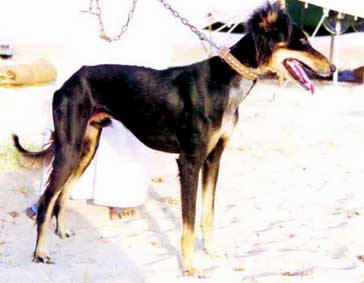
The northern frontiers of Salukidom

When I lived for five years in Iraq in 1985-90 I used often to think as I visited
Iraqi hunters in the north of the country that I was crossing and recrossing
an invisible frontier between two distinct Saluki populations.
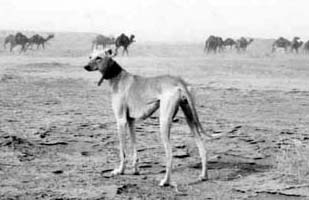
Tayra: this is my smooth
Saluqi from Iraqi Kurdistan.
Political restrictions on travel to Iran and the Soviet Union at that time meant that it was not possible for me to go further afield to see how far the more northerly population extended, though I managed some forays into eastern Turkey, where I saw similar Salukis to those in northern Iraq and Syria. Even now, travel in this region is by no means easy to gain first-hand information. However some recent contacts with people who are familiar with the region and our breed have given some insights which are worth sharing with a wider audience.
Last summer I found myself on an archaeological tour in Turkey, travelling in the steps of Alexander the Great. Among my companions were a former British Ambassador to Afghanistan and his wife, Peers and Joan Carter. Somehow or other a conversation with them turned to Salukis. As we talked, one of them produced from a book, where it served as a page marker, an old black and white photograph of what I took to be a Saluki. It was in fact a photograph of their own very special hound - Chipak, the Afghan name of a small falcon used for hunting quail. She had been given to them as an Afghan puppy from the royal kennels in 1968 by Princess Bilqis, daughter of the last King of Afghanistan, Zahir Shah. The Carters said that they saw very few Tazis in Afghanistan, where they were considered as belonging to the Crown, rather like swans in Britain: indeed they had to have a special licence to take Chipak out of the country. She went on many expeditions across Afghanistan with the Carters and proved to be an excellent hunter of hare and even marmots, which she used to creep towards until she was near enough to snatch them before they disappeared down their burrows. When the Carters returned to Britain in 1973, they encountered considerable difficulty in having her registered at the Kennel Club as an Afghan and had to gather evidence of her lineage from members of the Afghan royal court, who had by then become dispersed in different countries after the revolution in their home country. But she was duly registered as Chipak Barqak, Chipak the Lightning, and went on to produce in 1974 an excellent litter of 8 puppies, as I discovered later on an afternoon's visit to the Carters, where I saw films of Chipak in action in Afghanistan and mothering her puppies here. I recently learned that some of her descendants continue in Australia.
Chipak engaged my particular interest because she was in so many respects closer to the northerly type of Saluki in appearance than to the average Afghan Hound, at least as we know it. Indeed Mrs Daphne Gie's book "The Complete Afghan" seems to acknowledge that Chipak looked different, describing the head as stronger and the eyes a little more full than is usually bred in Britain and the coat conforming more to the Lochak type of Afghan, which is rarely seen in the West nowadays. Certainly the photographs of her as a puppy show a hound which is virtually indistinguishable from many Iraqi Salukis.

Chipak as a puppy by Peers Carter
The somewhat heavy black muzzle is occasionally found among hounds in northern and western Iraq
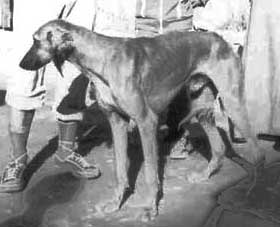
Black-masked red dog
at Rutba, Iraq
As she grew older she appears in photographs to become more typically Afghan-looking and her puppies
certainly bred true to the type more usually seen in the West.
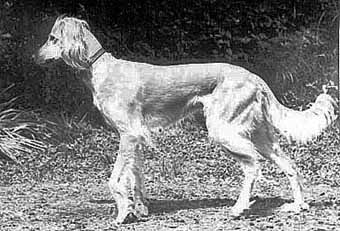
Chipak, by Peers Carter
Nevertheless we have here an excellent example
of how the Saluki shades into another variant
which has evolved for hunting in the different
conditions of the mountains of Afghanistan.
Interestingly, Abdul Wali, the husband of Princess Bilqis, offered the Carters a smooth-haired Afghan Hound
before they left but they had to decline it, as they felt one hound was quite enough to cope with in the very
different circumstances of their retirement in Britain.
Looking at Chipak reminded me of an article I saw reproduced some years ago in the New Zealand Kennel Gazette by a Soviet cynologist, Michail Lebedev, entitled "The original Borzoi breeds from the Soviet Union", in which he describes the Central Asian Wolfhound Tazy and the Central Asian Wolfhound Taigan. The accompanying photograph of the Taigan shows a hound very similar to Chipak. Another photograph showing a black and white Tazy looks remarkably like Sarona Kelb in old age. Can these be "original Borzoi breeds" or are they merely further variations on the Saluki? A Finnish correspondent, Sari Mantila, with experience of such hounds sent me a collection of photographs taken in Russia in which the so-called Tazys look extraordinarily like our own Salukis.
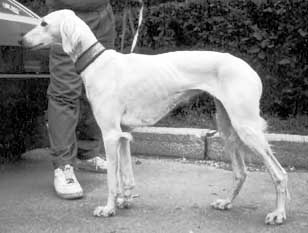
Belosnezhanka, photo by Y Nikolaev
There is ample historical evidence to suggest the
existence of Sighthounds in Central Asia for thousands
of years but we know more particularly from the history
of the Muslim conquests that people from the Arabian
heartland penetrated there and that hunting with falcon and Saluki was for them a major pastime.
David and Hope Waters' book "The Saluki in History, Art and Sport" offers a beautiful picture entitled "Hunters homeward bound" by the 10th century Chinese artist Hu Huai, showing three unmistakable Salukis carried back by their masters on their horses from hunting in the steppes, which clearly indicates that the Saluki was a familiar part of the hunting scene there a thousand years ago. What could be more natural therefore than that such hounds should have been established among the local tribes, with whom they have stayed to this day, possibly evolving little local characteristics, such as longer hair or a more rugged build, along the way?
Among the other people on the archaeological trip to Turkey was another distinguished former British Ambassador, Sir Denis Wright, who spent 8 years in Iran under the Shah. Hearing of my interest in Salukis, he said he would like me to meet on his forthcoming visit to Britain Lev Tamp, a remarkable old man from Tehran, who hunted and bred Salukis in Iran. An invitation to lunch duly came in September and what a fascinating story Lev Tamp had to tell! He is 92 years old but sprightly and fluent in at least half a dozen languages. He was born an Armenian in Georgia under the Czar but reached maturity under the Soviets. He fled Communism by swimming across the Araks river from Soviet Armenia into Persia, from where he went to Germany, but in 1933 when Hitler came to power he returned to Persia. He worked in Iran as a road-building engineering contractor, travelling widely in the country; but in 1946 when the Communists came to power for a while, he went to Iraq with the intention of emigrating to Australia. However while in Baghdad he was invited to the Royal Harthiya Hunt, patronised by the Regent Abdulillah. He stayed on there, eventually becoming a Huntsman, and could allow his passion for hunting full rein The pack consisted not of Salukis but Dorset Foxhounds.
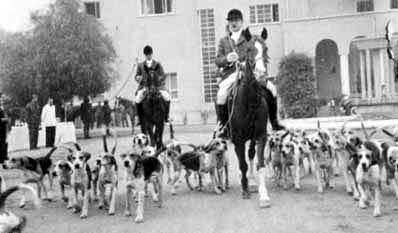
The Royal Harthiya Hunt, by Lev Tamp
The revolution in 1958 forced him back to Tehran where he has lived ever since, indulging all the while
his passion for hunting with his horses and Salukis
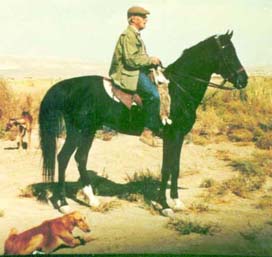
Lev Tamp mounted with Salukis,
by Margret Tamp
And now to his Salukis....
They are feathered, substantial hounds of the northerly
type measuring 24-27" (62-70 cms) at the shoulder,
built for hunting on the high plateaux below the Elburz Mountains.
In Iran they call the largest and heaviest hounds "dolaa", which are used for hunting wolves, to distinguish them from the more common smaller desert type of Tazi. The Tamps' hounds are somewhere in between these two types. Until a few years ago Lev was still hunting regularly on horseback with his Salukis but now leaves that kind of activity to his German-born wife, Margret. They have been breeding their own line for decades, occasionally outcrossing with a proven coursing hound from the Kurds in that area. They bred last summer a litter from their four-year-old dark beige bitch Minou and an unusual jet black Kurdish dog, like the one in the photograph.
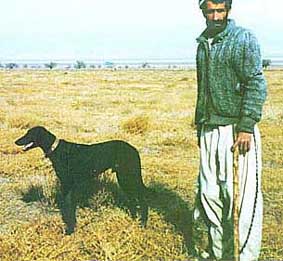
Black Kurdish dog
The beautiful puppies included two black-masked red dogs,
one of which at 10 months measured 28" at the shoulder with
a body length of 27" while the other was an inch smaller,
a cream bitch 24" tall and 23" long and a jet black dog with just a white tip to his tail and a small patch on the chest measuring 28 1/2"x 27".
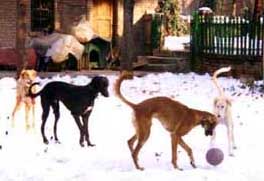
Puppies in Tehran,
by M. Tamp
They are undoubtedly fine Salukis but with their colouring and substantial build have something in common with the hounds more usually found further north and east in Central Asia, which is after all only a few hundred miles away.
The Tamps told me a story which further illustrates the overlapping of types in this region. It seems they were travelling some years ago in Central Afghanistan near the famous minaret of Jam, about 200 kms west of Bamyan, where they caught sight of some Salukis looking almost like their own. They asked to see them but there was some delay before they were brought out of the tribal tents covered with beautiful green silk coats. That must have been a sight! But it is particularly noteworthy that the Tamps emphasised that these were Salukis, albeit a long way from what might be regarded as their usual confines.
In recent years the Tamps have noticed a decline in the number of Salukis in their area, though they are still to be found, albeit mainly among the Kurds and gypsies, as in northern Iraq and Syria and south-eastern Turkey. Until a few years ago there was a Turkic tribe living in a rather rundown quarter of Ghasvin about 150 kms west of Tehran and nearly every house had a couple of Salukis for hunting foxes and other small animals for their fur, which was traded commercially. (This mirrors the practice in Kazakhstan where in the 1930s Tazys were being bred in their thousands for commercial hunting for furs.) However development of Ghasvin seems to have overtaken this tribe and they no longer go hunting. As elsewhere in the region, the Kurds tend to crop their hounds' ears in the belief that wolves cannot hurt them so easily; whereas they do not remove dew claws as they are regarded as useful for running. The Kurds breed on the basis of best to best available in their village but will go further afield if necessary. They judge a Saluki's quality mainly on its performance.
The Kurds cover a huge area of Western Asia and despite political boundaries they have always exercised their independence by migrating this way and that according to the economic and political pressures of the time. Wherever there are Kurds there are Salukis: certainly in Iran, Iraq and Syria but also in Turkey. Last summer a Saudi Prince made a shopping expedition to Turkey - for Salukis! He drove north through Syria, where he could not find what he wanted, into Turkey and by touring through the Kurdish villages he bought some fourteen mature hounds for his hunting trip to Sudan later in the year. These hounds give a somewhat different impression from the usual images of Turkish Tazis and appear to be literally borderline between the more northerly and the southerly types.
Black & tan Turkish dog, by M Ratcliffe
Nearly all these hounds were smooth, which surprised Edgar Berghaus, the noted German expert on Turkish Tazis, who had never come across smooths in his tours of areas further north in Central Anatolia. Twelve of the hounds were black and tan and two, both females, were a sandy red. As is the usual Kurdish practice nearly all the hounds had had their ears cropped, which always distorts their appearance, especially when the ears have been cropped unevenly. Most were substantially built and tended to be taller than long in construction. The biggest dog measured 2 3/4" taller than long and three of the others were 2" taller than long. Altogether six were taller than long, five were square and only three were slightly longer than tall. The Prince took some of them to the Sudan along with some of his other Saudi-bred hounds. The remarkable outcome of this trip was that over six weeks the top hound on gazelle was a feathered black and tan Turkish dog of quite a light build, measuring 26" tall x 24 1/2" long, which had been initially prostrated by the heat in Saudi Arabia and which had not seen gazelle before whereas the top hound on hare was a more substantial smooth red Turkish bitch.
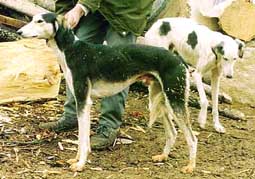
Turkish Tazis in Central Anatolia by Edgar Berghaus

Red Turkish bitch,
by M Ratcliffe
The outstanding performance of the feathered black and tan in desert conditions is particularly noteworthy
because it flies in the face of theories to the effect that dark coloured and feathered hounds evolved through
selection for hunting over the more varied terrain of more northerly climates.
The smooth red bitch might be regarded as more appropriate for desert conditions, except she came from the
same part of Turkey as the black and tan.
It is difficult to draw any firm conclusions from these small samples without more scientific examination of their genetic make-up but at least superficially the resemblance between all these hounds from over a wide area is so striking that unless proved otherwise there must be a presumption that they are one and the same breed, showing only minor local variations.
©
Ukrainian magazine "Naturalist"This article was first published in "Saluki International", volume six, issue twelve,
spring/summer 1998.